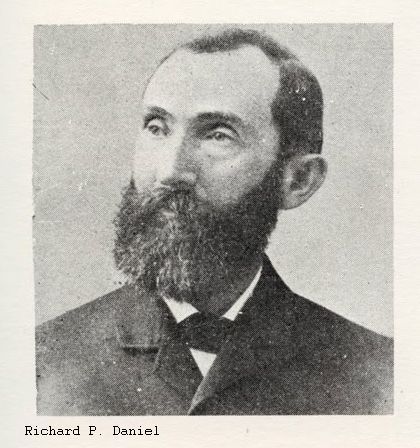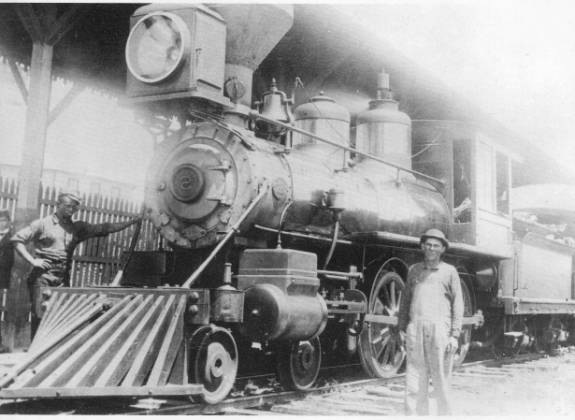IV. THE JACKSONVILLE & ATLANTIC RAILWAY (1893-1899)
So with a
legal wizardry, the bankrupt Jacksonville and Atlantic Railroad arose
from the fire of bankruptcy like a phoenix but with a new moniker, the Jacksonville
and Atlantic Railway, and less debt. The court foreclosed in 1890; the
corporation went into receivership to liquidate as many debts as possible and
then was sold on December 5, 1892 by Special Master to M. Drew the property to
the Jacksonville and Atlantic Railway Company on January 18, 1893. Obviously, this was a "done deal"
decided long before. The outstanding obligations of the J & A Railroad
Company were assumed by the J & A Railway Company according to Seth
Bramson. On January 23, 1893, the new corporation acquired the right to use
tracks of Jacksonville, St Augustine, and Indian River Railway Company from the
South Jacksonville rail yard to the ferry dock.
At the
beginning of1893, Drew was President,
Archibald the Vice President, MacDuff the Secretary, and Hazeltine the
Treasurer. Hayden remained the General Superintendent. The chief passenger and
freight agent was James I. Munoz. John Whitaker was Chief Engineer and Foreman Locomotive Repairs. The Master
Mechanic was J. E. Clark.[1]
As the
railroad continued to falter, its leadership changed. On January 24, 1894,
Hazeltine, James W. Archibald, MacDuff, and W. B. Barnett became Directors with
Archibald serving as President, Hazeltine as Vice President and MacDuff as
Secretary Treasurer. By 1898 MacDuff had replaced Hazeltine as vice-president
and Barnett had become secretary-treasurer.
James W.
Archibald, born July 4,1848 in Scotland, was brought to the United States in
1851. By 1876, he involved himself in the real estate and insurance businesses.
The 1880 census said he was n unmarried broker. In 1882, he was a lawyer and
loan agent. He married Isabelle Spafford , originally of Watertown, NY in 1885;
their daughter, Mary E. Archibald was born in 1888 when he was forty. He was served as Acting Mayor in August,
1888, meeting with the Board of Trade, city and county boards of health, city
council and county commission to create the Jacksonville Auxiliary Sanitary
Commission to deal with yellow fever epidemic. In 1894, he, as railroad president,
purchased lots in the St.
Nicholas Cemetery for African Americans, presumably railroad workers.
Besides his law practice and the railroad, he engaged in civic activities. He
was President of the Board of Trustees on the Jacksonville City Library in
1913. He died April 1, 1921.[2]

William B. Barnett
David J.
Ginzl presents us with a very good insight into William Boyd Barnett[3]
founder of one of the most powerful banks in the state of Florida when he
opened the Bank of Jacksonville in May, 1877. He was born September 2, 1825 in
Nichols County, VA [now WV] but his family moved to Greenfield, OH in 1826. The
family suffered hard times in 1838, necessitating his leaving school to apprentice himself to a saddle and
harness maker. In 1842, he struck out on his own and, in three years, saved $100.
He then went west to Leesburg, Indiana and invested the money on a
saddle and harness shop. Barnett married Sarah Jane Blue on November 9, 1848;
their son William D. Barnett was born April 3, 1852 and their son Bion Hall
Barnett on October 7, 1857. He expanded his business activity by becoming a
partner in a successful country store.
Some men
would have been content to spend the rest of their lives in his wife's home
town but not Barnett who searched for better business opportunities. He sold
out and moved to Hiawatha in northeast Kansas where he bought Dutton’s general store for $75. His business
prospered; he delved in politics, becoming on board of county commissioners and
then county treasurer. He also became a
stockholder and treasurer of the Northern Kansas Railroad. An advocate of
railroad expansion, he wanted the St. Joseph and Grand Island Railroad to go
through Hiawatha; that segment was completed by 1870. Barnett had extensive
land holdings in the area.
In 1871,
Barnett sold his store and in a partnership with Lorenzo Janes and Major E. N.
Morrill formed Barnett, Morrill & Company. Janes
was a Vermont banker and Morrill was Governor. In March, 1877, Barnett
followed his son, William D. Barnett, to Jacksonville and created his private
bank, the Bank of Jacksonville, with $40,000 in capital, a considerable amount.
His sons involved themselves in civic affairs and important social
organizations. Bion married into the powerful L'Engle family which paid off
in1880 when Henry L’Engle, Duval County tax collector, moved the county's funds
to Barnett's bank. He sold stock to John G. Christopher, Leopold Furchgott, and
Joseph H. Durkee, an important politician. He converted the business into the
National Bank of Jacksonville in May, 1888. Eventually, the Barnett Bank became
the most powerful bank not only in Jacksonville but in the state of Florida.
James
Murdoch Barrs, born 1857, was a distinguished lawyer who served twenty years as
a state attorney. He and Governor Napoleon Broward helped established the new
progressive wing of the Democratic Party.
J. M. had been involved in the first incarnation of this railroad, as we
know.

Richard
Potts Daniel[4] was born
August 19, 1828 in Pineville, SC, the oldest of the clan that included James
Jaquelin Daniel. He attended the Medical College of South Carolina in
1848-1854. As a new M. D. he entered the United States Navy. When the Civil War
erupted in 1862, he became the Chief
Surgeon of the 8th Florida Infantry of the Confederate States of
America. After the war was lost, he
considered self-exile in Brazil or Mexico but decided it more practical to stay
in Florida. He became Secretary of the Duval Medical Society in 1865 and its
President by 1877. He became a strong advocate of public health measures in
light of yellow fever outbreaks. When, in 1887, he was President of Florida Medical Association, he
tried to get Florida's government to create a State Board of Health. His
younger brother, Jaquelin, who was a director of the J&A Railroad, died in
the 1888 yellow fever.
In 1897,
Archibald was listed as the General
Manager. Trains left Jacksonville for South Jacksonville at 10:00 AM, 2:00 PM,
3:30 PM arriving at Pablo Beach at 11:00 AM, 3:00 PM, and 4:30 PM. They left Pablo Beach at 11:45 AM, 12:30 PM, 1:30
PM, and 4:40 PM arriving in Jacksonville an hour later. Connections to the Jacksonville, Tampa, and Key West, the
Florida East Coast, the Florida Central and Peninsular, and Savannah, Florida and Western railroads
were available in South Jacksonville.[5]

J&A Locomotive, Pablo Beach, 1898 Courtesy The Bramson Archive

J&A Baggage Car Courtesy
The Bramson Archive
Total
revenues of the little road never exceeded $20,000 per year during the 1890s,
and expenses usually matched or exceeded income.[6]
The road enjoyed a surfeit of passengers only four months a year. The Panic of
1893, an economic depression that lasted until 1897, lessened the possibility
of profit. Fewer people had the money to travel to the beach or build dwellings
there. Railroads throughout the nation went bankrupt. The J&A probably
survived as long as it did because powerful and often wealthy families needed
it to use their beach cottages but it was not viable.
As the Boston Evening Transcript reported, Henry Flagler and his
associates have quietly been buying up all the property on the south side of
the St. Johns River from Jacksonville to Mayport and the lands south to Pablo
Beach. He bought the Jacksonville & Atlantic Railway and the title and
rights of the Jacksonville, Mayport, and Pablo Railway and Navigation Company.[7]
The Jacksonville & Atlantic Railway was swallowed by the Florida East Coast
Railway and became its Beach or Mayport Branch.

